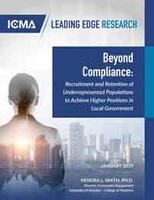
By Kendra Smith
Seeking to become more proactive and inclusive, many local jurisdictions are endeavoring to go “beyond compliance” and create substantive programs that recruit, hire, and retain underrepresented populations into their ranks.

1. Create clear job descriptions that are position-specific. A well-written description clearly identifies the responsibilities of the job, details the skills required to meet those responsibilities, and sets expectations for performance.
In contrast, poorly conceptualized and written job descriptions can be exclusionary, unclearly state the nature of the position, spur unqualified applicants to apply, and deter qualified applicants from applying.
Avoid such job description pitfalls as not expressing a commitment to diversity, equity, and inclusion; not connecting position responsibilities to organization objectives; or overemphasizing the minutia that comes with any job.
2. Avoid coded language in job descriptions. Even though the job description does not explicitly state a male or female is sought for a position, the choice of certain words can signal an invitation to one group to apply and a deterrence to another.
According to the Journal of Personality and Social Psychology, for instance, in male-dominated positions, such words as competitive, enforcement, fearless, and leader may be used, while words like understand, transparent, catalyst, supportive, and interpersonal may be used in female-dominated areas.
Organizations, however, no longer need to guess whether they are placing biased language in their job descriptions. There are software platforms available to analyze job descriptions for bias and gendered language.
3. Audit the organization’s job descriptions immediately and regularly. According to the Society for Human Resource Management, organizations should conduct an audit of their job descriptions every few years to ensure that they accurately reflect the work to be done. An industrial psychologist can help with this work.
Among other things, industrial psychologists are trained to assess critical competencies needed for jobs, design unbiased screening tools based on the actual needs of the job, and audit organizational hiring processes to identify potential legal risks.
If hiring an industrial psychologist is not possible, a feasible next step is assembling an interorganizational task force made up of people with expertise in human resources (HR), law, diversity, equity and inclusion, and leadership.
4. Examine your screening requirements to ensure inclusion. Tests rarely provide a whole picture of a candidate’s traits. A critical eye can determine whether tests are needed or if they are merely evaluating skills the candidate will learn on the job.
Tests also should be examined to ensure that there aren’t discriminatory measures in place that can exclude potential applicants. Robust recruitment and hiring processes, including well-written job descriptions, validated exams or assessments, and diverse panels are likely to weed out unqualified candidates.
Through these steps, HR can improve hiring practices, ground standards in fact, and hire qualified candidates.
To gain more insight into equitable hiring, specifically around gender and inclusion, attend the ICMA University webinar “Interest, Confidence, Risk, Reward: Getting More Women into Local Government Management Positions” on March 26, 2019.
This webinar is available to ICMA members for free as a member benefit. To read more about recruiting and retaining underrepresented populations, download “Beyond Compliance” at icma.org/beyond-compliance.

Kendra Smith, Ph.D., is director, community engagement, University of Houston College of Medicine, Houston, Texas (klsmith14@uh.edu).
New, Reduced Membership Dues
A new, reduced dues rate is available for CAOs/ACAOs, along with additional discounts for those in smaller communities, has been implemented. Learn more and be sure to join or renew today!
